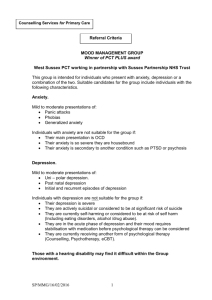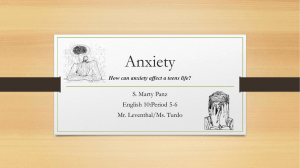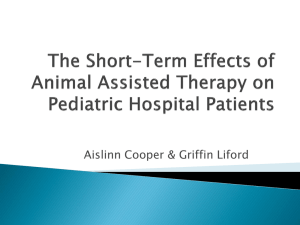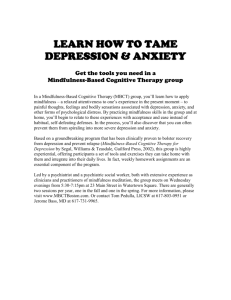Document 10467321
advertisement
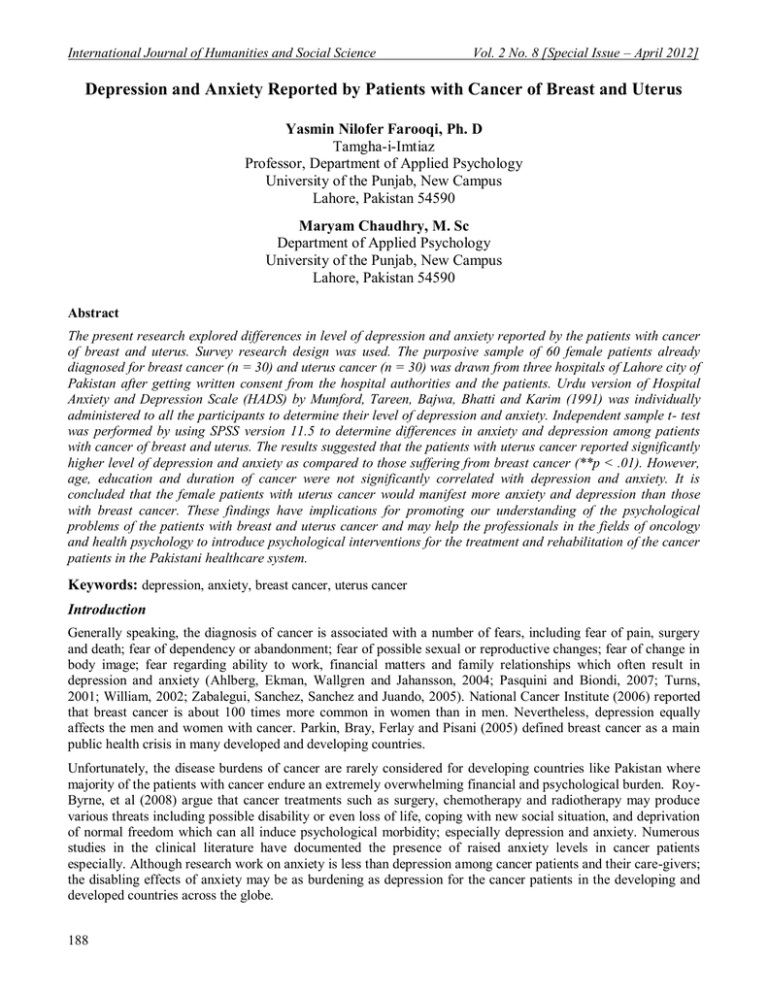
International Journal of Humanities and Social Science Vol. 2 No. 8 [Special Issue – April 2012] Depression and Anxiety Reported by Patients with Cancer of Breast and Uterus Yasmin Nilofer Farooqi, Ph. D Tamgha-i-Imtiaz Professor, Department of Applied Psychology University of the Punjab, New Campus Lahore, Pakistan 54590 Maryam Chaudhry, M. Sc Department of Applied Psychology University of the Punjab, New Campus Lahore, Pakistan 54590 Abstract The present research explored differences in level of depression and anxiety reported by the patients with cancer of breast and uterus. Survey research design was used. The purposive sample of 60 female patients already diagnosed for breast cancer (n = 30) and uterus cancer (n = 30) was drawn from three hospitals of Lahore city of Pakistan after getting written consent from the hospital authorities and the patients. Urdu version of Hospital Anxiety and Depression Scale (HADS) by Mumford, Tareen, Bajwa, Bhatti and Karim (1991) was individually administered to all the participants to determine their level of depression and anxiety. Independent sample t- test was performed by using SPSS version 11.5 to determine differences in anxiety and depression among patients with cancer of breast and uterus. The results suggested that the patients with uterus cancer reported significantly higher level of depression and anxiety as compared to those suffering from breast cancer (**p < .01). However, age, education and duration of cancer were not significantly correlated with depression and anxiety. It is concluded that the female patients with uterus cancer would manifest more anxiety and depression than those with breast cancer. These findings have implications for promoting our understanding of the psychological problems of the patients with breast and uterus cancer and may help the professionals in the fields of oncology and health psychology to introduce psychological interventions for the treatment and rehabilitation of the cancer patients in the Pakistani healthcare system. Keywords: depression, anxiety, breast cancer, uterus cancer Introduction Generally speaking, the diagnosis of cancer is associated with a number of fears, including fear of pain, surgery and death; fear of dependency or abandonment; fear of possible sexual or reproductive changes; fear of change in body image; fear regarding ability to work, financial matters and family relationships which often result in depression and anxiety (Ahlberg, Ekman, Wallgren and Jahansson, 2004; Pasquini and Biondi, 2007; Turns, 2001; William, 2002; Zabalegui, Sanchez, Sanchez and Juando, 2005). National Cancer Institute (2006) reported that breast cancer is about 100 times more common in women than in men. Nevertheless, depression equally affects the men and women with cancer. Parkin, Bray, Ferlay and Pisani (2005) defined breast cancer as a main public health crisis in many developed and developing countries. Unfortunately, the disease burdens of cancer are rarely considered for developing countries like Pakistan where majority of the patients with cancer endure an extremely overwhelming financial and psychological burden. RoyByrne, et al (2008) argue that cancer treatments such as surgery, chemotherapy and radiotherapy may produce various threats including possible disability or even loss of life, coping with new social situation, and deprivation of normal freedom which can all induce psychological morbidity; especially depression and anxiety. Numerous studies in the clinical literature have documented the presence of raised anxiety levels in cancer patients especially. Although research work on anxiety is less than depression among cancer patients and their care-givers; the disabling effects of anxiety may be as burdening as depression for the cancer patients in the developing and developed countries across the globe. 188 The Special Issue on Contemporary Issues in Social Science © Centre for Promoting Ideas, USA www.ijhssnet.com Massie and Holland (2001) report that most women experience overwhelming psychosocial distress during the course of their breast cancer and uterus cancer diagnosis and treatment. However, the level of distress varies from woman to woman and within an individual over the course of diagnosis and treatment for cancer. There is sufficient empirical evidence that most of the female patients with uterus and breast cancer end up feeling anxious and depressed when given this diagnosis mainly because of fear of pain, surgery and death; fear of dependency or abandonment; fear of possible sexual or reproductive changes; fear of change in body image; fear regarding ability to work, financial matters and family relationships (Abela and D'Alessandro, 2010; Brintzenhofe-Szoc, Levin, Li, Kissane and Zabora, 2009; Dogar, et al., 2009; Ell, et al., 2005; Fafouti, et al., 2010; Gingras and Jose, 2007; Iwamitsu, et al., 2005; Lueboonthavatchai, 2007; Lyons and Shelton, 2004; Manog, et al., 2006; Miranda, Resende, Melo, Costa and Friedman, 2002; Suzuki, et al., 2011). Thus, it may be inferred from the above-mentioned review of literature that depression and anxiety are the major psychological problems which the Pakistani female patients with cancer of breast and uterus would also experience during the course of their illness and treatment. However, very few researches have been carried out in this field in the Pakistani healthcare system. Thus, the current research is an attempt to promote our knowledge about depression and anxiety among Pakistani female patients with cancer of breast and uterus. The main objective of the current research was to explore differences in the level of depression and anxiety reported by the female patients with cancer of breast and uterus. Furthermore, it explored relationship between duration of cancer since its diagnosis and level of depression and anxiety among these patients. Method Sampling Strategy and Sample Non-probability purposive sampling technique was used. The following inclusion criteria were used: 1. Hospitalized female patients already diagnosed for cancer of breast and uterus during the past two months; but not more than five years. 2. Age range of the participants within 31-60 years. 3. All married female patients with cancer of breast and uterus without any past history of divorce or separation or remarriage. 4. No history of previous psychiatric illness, especially that of depression and/or anxiety. 5. No known history of infertility. 6. Willingness to participate in this research project. The sample was composed of 60 hospitalized female patients already diagnosed by their treated oncologists for at least past two months (30 patients with breast cancer and 30 patients with uterus cancer). The sample was drawn from INMOL Hospital (50%), Ganga Ram Hospital (30%), and Lady Wellington Hospital (20%) of Lahore city of Pakistan. The researchers contacted 80 patients with breast cancer and uterus cancer; however only 60 of them (75%) volunteered to participate in this research project. It may be argued that 75% of the response rate versus 25% of the dropout rate would not threaten the internal validity of this research project considering the sensitive nature of this research project for the traditionally patriarchal Pakistani society. Instruments The following instruments were used for data collection: 1. Urdu Version of Hospital Anxiety and Depression Scale (HADS) by Mumford, Tareen, Bajwa, Bhatti and Karim (1991). 2. Demographic Information Form 1. Hospital Anxiety and Depression Scale (HADS Urdu Version) Urdu Version of HADS was used to assess the level of anxiety and depression reported by the patients with cancer of breast and uterus. This scale was copyrighted and written permission was granted by the authors of Urdu Version of HADS. HADS (Urdu version) consists of 14 statements. Items no. 1, 3, 5, 7, 9, 11 and 13 measure anxiety and items no. 2, 4, 6, 8, 10, 12 and 14 measure depression. The lowest possible score on each scale is 7 and highest possible score is 21. Each statement has four optional responses which are scored, as follows: 189 Vol. 2 No. 8 [Special Issue – April 2012] International Journal of Humanities and Social Science Optional Responses Most of time A lot of time Time to time Not at all Scores 3 2 1 0 2. Demographic Information Form Demographic Information Form was developed by the researchers to gather information about participants’ age, education and duration of cancer of uterus or breast since its diagnosis. The demographic characteristics of the sample are given in Table 1. Table 1: Demographic Characteristics of the Sample (N = 60) Characteristics Age 31- 40 41- 50 51- 60 Education Under Matric Matric to Intermediate Graduation to Masters Total Sample (N = 60) Freq Percent Breast Cancer (n = 30) Freq Percent Uterus Cancer (n = 30) Freq Percent 27 26 07 45 43 12 10 17 03 33 57 10 17 09 04 57 30 13 28 09 23 47 15 38 11 06 13 37 20 43 17 03 10 57 10 33 09 14 37 15 23 62 05 06 19 17 20 63 04 08 18 13 27 60 Duration for Diagnosis of Cancer 2 months to 1 years 2 years to 3 years 4 years to 5 years Note. Freq = Frequency; Percent =Percentage and N/n = number of patients. Procedure Official permission was sought from the Medical Superintendent (M.S.) of the above- mentioned hospitals for data collection. Before administration of the Demographic Information Form and HADS, the participants were briefed about the nature and purpose of the study. They were assured that all the information given by them would be used for research purposes only. Written consent was individually obtained from all the participants who volunteered to participate in this project. Then, Demographic Information Form and HADS were individually administered to all the research participants. Independent sample t-test was performed to analyze differences in level of depression and anxiety reported by the patients with cancer of breast and uterus. Moreover, Pearson Product-Moment Correlation Coefficient was performed to determine relationship between depression, anxiety and duration of diagnosis of cancer of uterus or breast. Results The results given in Table 2 indicate Cronbach’s Alpha coefficient value (α = .73) for HADS which suggests statistically high reliability of HADS for the current sample. Table 2 : Reliability of Hospital Anxiety and Depression Scale (Urdu Version) by Mumford, Tareen, Bajwa and Karim (1991) HADS 190 α .73 Items 14 The Special Issue on Contemporary Issues in Social Science © Centre for Promoting Ideas, USA www.ijhssnet.com The results given in Table 3 indicate that the patients with uterus cancer reported significantly higher level of depression and anxiety as compared to those with breast cancer (t = - 3. 31, ** p < . 01; t = - 3. 00, ** p < .01, respectively). Table 3: Differences in Level of Anxiety and Depression Reported By Patients of Breast Cancer and Uterus Cancer (N = 60) Variables Depression Anxiety Breast Cancer M SD 12.93 3.86 13.67 4.63 Uterus Cancer M SD 16.07 3.46 16.43 2.01 t (58) - 3.31 - 3.00 Cohen’s d - .86 - .78 99% CI LL UL - 5.20 - 1.59 - 4.80 - 1.07 p <.001 <.001 Note. CI= confidence interval; LL= lower limit; UL= upper limit. The results given in Table 4 indicate no significant relationship between duration of cancer and level of depression and anxiety reported by the patients with cancer of breast and uterus. Table 4: Relationship between Depression, Anxiety and Duration of Cancer (N = 60) 1. 2. 3. 4. Variables Duration of Cancer Types of Cancer Depression Anxiety M 2.47 1.50 15.03 14.63 SD .75 .50 3.86 3.86 1 .00 .09 .04 2 3 4 .38 .44 .27 - Discussion The current research findings suggest that the patients with cancer of uterus reported significantly higher level of anxiety and depression as compared to those suffering from breast cancer; probably because the uterus cancer threatens the female patients’ reproductive capacity as a wife and a mother which are the primary stereotypical roles assigned to the Pakistani women in this traditional patriarchal society. It may be argued that myths and misconceptions about cancer of uterus may further exacerbate anxiety and depression in these female patients. The current research findings are consistent with the previous research findings of Lyons and Shelton (2004); Miranda, Resende, Melo, Costa and Friedman (2002); Simonelli, Fowler, Maxwell and Andersen (2008) which indicated that the patients with uterus cancer reported more anxiety and depression as compared to those with breast cancer. However, no significant relationship was found between duration of diagnosis of breast cancer or uterus cancer and level of anxiety and depression. These findings are also consistent with the research findings of Jadoon, Munir, Shahzad and Choudhry (2010); Allen, Newman and Souhami (1997); Nordin, Berglund, Glimelius and Sjoden (2001); Schofield, et al (2003) which suggest no significant relationship between duration of cancer and level of depression and anxiety. Limitations and Suggestions The current research findings are limited to the female Pakistani cancer patients within age range of 31 to 60 years. Therefore, it is recommended that the future researches must compare the female patients with breast cancer and uterus cancer from diverse age groups. Moreover, in the current research project only married female patients were included. The future researches must compare anxiety and depression in the married and the unmarried female patients with breast and uterus cancer. The sample size in the current research project was somewhat small; probably because the majority of the female Pakistani cancer patients were reluctant to participate in any research project due to socio-cultural inhibitions and taboos. Therefore, the current findings cannot be generalized to the larger population of patients with breast cancer and uterus cancer. Perhaps, clinical interview or focus group discussion could be used in future researches to encourage the female cancer patients to participate so that we could get a larger sample for comparative analysis. 191 International Journal of Humanities and Social Science Vol. 2 No. 8 [Special Issue – April 2012] Implications The findings of this research have implications for promoting our understanding and knowledge of the psychological problems of the patients with cancer of breast and uterus. This may further help the professionals in the fields of oncology, clinical and health psychology to introduce psychological interventions and counseling for the treatment and rehabilitation of the cancer patients in the Pakistani healthcare system. Author’s Note Written permission was granted by Prof. Dr. Riaz Bhatti, on the behalf of the research team (Mumford, Tareen, Bajwa, Bhatti and Karim, 1991) to Maryam Chaudhry under the supervision of Dr. Yasmin Nilofer Farooqi (Tamgha-i-Imtiaz), Professor, Department of Applied Psychology, University of the Punjab, Lahore, Pakistan for use of Urdu Version of Hospital Anxiety Depression Scale (HADS) in the current research project. References Abela, J. R. Z., & D'Alessandro, D. U. (2010). Beck's cognitive theory of depression: A test of the diathesis-stress and causal mediation components. British Journal of Clinical Psychology, 41 (2), 111-128. DOI: 10.1348/014466502163912 Ahlberg, K., Ekman, T., Wallgren, A., & Jahansson, G. F. (2004). Psychological distress, coping and quality of life in patients with uterine cancer. Journal of Advance Nursing, 45, 205-213. Allen, R., Newman, S. P., & Souhami, R. L. (1997). Anxiety and depression in adolescent cancer: Findings in patients and parents at the time of diagnosis. European Journal of Cancer, 33 (8), 1250-1255 Brintzenhofe-Szoc, K. M., Levin, T. T., Li, Y., Kissane, D. W., Zabora, J. R. (2009). Mixed Anxiety/Depression Symptoms in cancer patients. Retrieved March 07, 2010, from http://www.psy.psychiatryonline.org/cgi/reprint/50/4/383.pdf Dogar, I. A., Azeem, M. W., Kiran, M., Hussain, I., Mehmood, K., & Hina, I. (2009). Depression and anxiety in cancer patients in outpatient department of a tertiary care hospital in Pakistan. Pakistan Journal of Medical Sciences, 25 (5), 734-737. Ell, K., Sanchez, K., Vourlekis, B., Lee, P. L., Johnson, M. D., Lagomasino, I., Muderspach, L., & Russell, C. (2005). Journal of Clinical Oncology, 23 (13), 3052- 3060 Fafouti, M., Paparrigopoulos, T., Zervas, Y., Rabavilas, A., Malamos, N., Liappas, I., & Tzavara, C. (2010). Depression, Anxiety and General Psychopathology in Breast Cancer Patients. International journal of experimental and clinical pathology and drug research, 24, 803-810. Gingras, B. A., & Jose, E. S. (2007). Depression in women with metastatic breast cancer. Retrieved March 14, 2010, from http://www.journals.cambridge.org/production/action/cjoGetFulltext?fulltextid. Iwamitsu, Y., Shimoda, K., Abe, H., Tani, T., Okawa, M., & Buck, R. (2005). Anxiety, Emotional Suppression, and Psychological Distress Before and After Breast Cancer Diagnosis. Psychosomatics, 46, 19-24 Jadoon, N. A., Munir, W., Shahzad, M. A., & Choudhry, Z. S. (2010). Assessment of depression and anxiety in adult cancer outpatients: a cross-sectional study. BioMedCentral, 10 (594), 1471-2407. doi:10.1186/14712407-10-594. Lueboonthavatchai, P. (2007). Prevalence and psychosocial factors of anxiety and depression in breast cancer patients. Journal of Medical Association Thailand, 90 (10), 2164- 2174. Lyons, M., & Shelton, M. (2004). 6 Psychological Impact of Cancer in Low-income Rural/ Urban Women. Online Journal of Rural Nursing and Health Care, 4 (2). Manog, P., Gangadharan, S., Nandkumar, D., Thomas, B., Badridien, H., & Rita, K. (2006). Distress, anxiety, and depression in cancer patients undergoing chemotherapy. World Journal of Surgical Oncology, 4, 14777819. Massie, M. J., & Holland, J. C. (2001). The cancer patients with pain. Psychiatric complications and their management, 71, 243-247. Miranda, C. R., Resende, C. N., Melo, C. F., Costa, A. L., & Friedman, H. (2002). Depression before and after uterine cervix and breast cancer neoadjuvant chemotherapy. International Journal of Gynecological Cancer, 12 (6), 773-776. Retrieved July 12, 2010, from http:\\www.ncbi.nlm.nih.gov/pubmed/12445259 192 The Special Issue on Contemporary Issues in Social Science © Centre for Promoting Ideas, USA www.ijhssnet.com Mumford, D. B., Tareen, I. A. K., Bajwa, M. A. Z., Bhatti, M. R. and Karim, R. (1991). The translation and evaluation of an Urdu version of the Hospital Anxiety and Depression Scale. Acta Psychiatrica Scandinavica, 83, 81–85. doi: 10.1111/j.1600-0447.1991.tb07370.x National Cancer Institute. (2006). Male Breast Cance. Retrieved April 23, 2010, from http:\\:www.cancer.gov/cancertopics/pdq/treatment/malebreast/.../page1 Nordin, K., Berglund, G., Glimelius, B., & Sjoden, P.O. (2001). Predicting anxiety and depression among cancer patients: A clinical model. European Journal of Cancer, 37 (3), 376-384. Parkin, D. M., Bray, F., Ferlay, J., & Pisani, P. (2005). Global Cancer Statistics. A Cancer Journal for Clinicians, 55 (2), 74- 108. doi: 10.3322/canjclin.55.2.74 Pasquini, M., & Biondi, M. (2007). Depression in cancer patients: a critical review. Clinical Practice and Epidemiology in Mental Health, 5, 502–511. Roy- Byrne, P. P., Davidson, K.W., Kessler, R. C., Asmundson, G. J., Goodwin, R. D., & Kubzansky, L. (2008). Anxiety disorders and comorbid medical illness. General Hospital Psychiaryt, 30 (3), 208-255. Schofield, P. E., Butow, P. N., Thompson, J. F., Tattersall, M. N. H., Beeny, L. J., & Dunn, S. M. (2003). Psychological responses of patients receiving a diagnosis of cancer. Annals of Oncology. Oxford Journals, 14 (1), 48- 56. Simonelli, E. L., Fowler, J., Maxwell, G. L., & Andersen, L. B. (2008). Physical Sequelae and Depressive Symptoms in Gynecologic Cancer Survivors: Meaning in Life as a Mediator. Annals of Behavioral Medicine, 35 (3), 275- 284. doi: 10.1007/s12160-008-9029-8. Suzuki, N., Ninomiya, M., Maruta, S., Hosonuma, S., Nishigaya, Y., Kobayashi, Y., Kiguchi. K., & Ishizuka, B. (2011). Psychological characteristics of Japanese gynecologic cancer patients after learning the diagnosis according to the hospital anxiety and depression scale. Journal of Obstetrics and Gynaecology Research, 37 (6). doi: 10.1111/j.1447-0756.2010.01437.x Turns, D. (2001). Psychosocial issues: pelvin exenterative surgery. Journal of surgical oncology, 76, 224-236. William, L. M. (2002). Is it appropriate to screen palliative care patients for depression? American Journal of Hospice and Palliative Care, 19 (2), 112-114. Zabalegui, A., Sanchez, S., Sanchez, P. D., & Juando, C. (2005). Nursing and cancer support groups. Journal of Advance Nursing, 51(4), 369-381. 193

